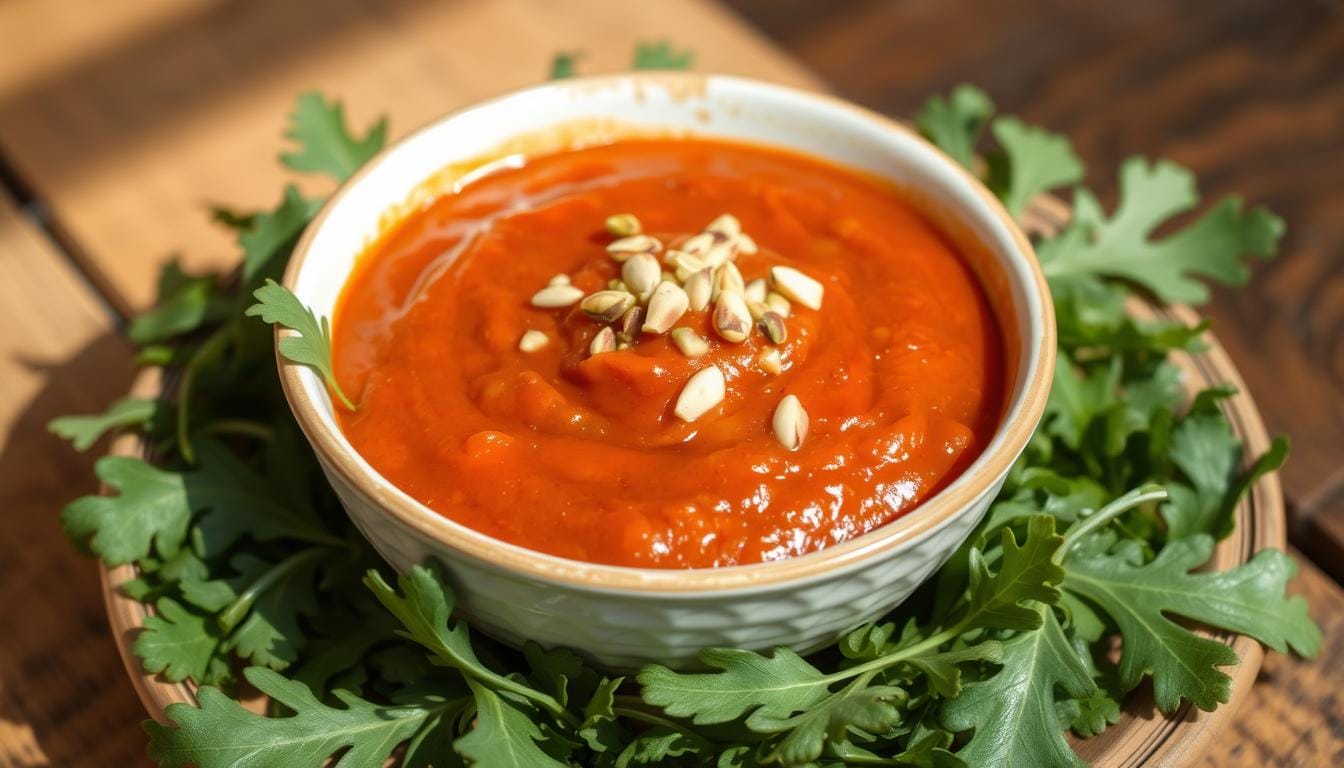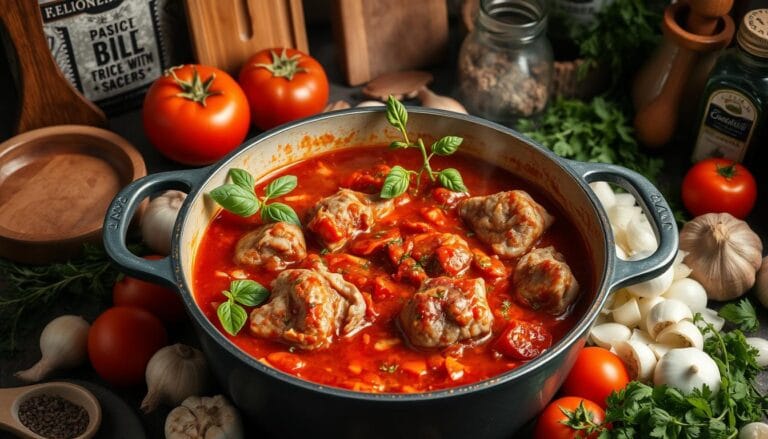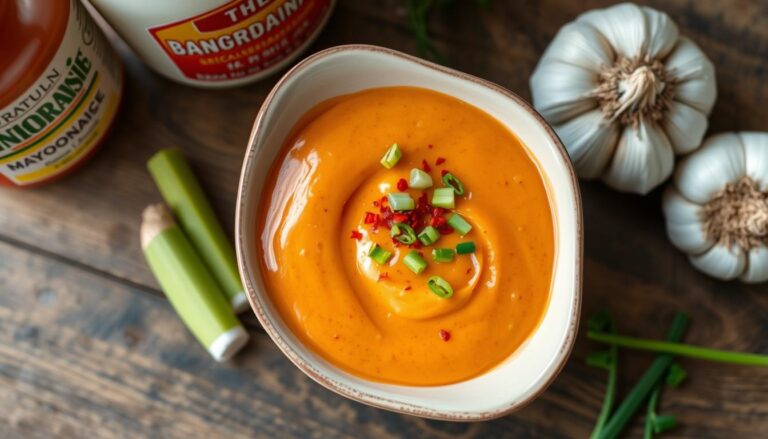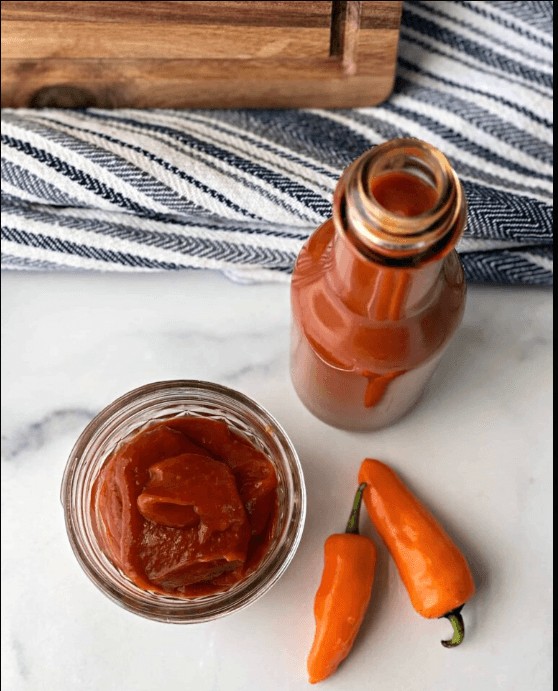Red Pepper Sauce Arugula Pistachio Pesto Recipe
As the sun set, it lit up my kitchen with a warm glow. I was excited to mix the deep-red peppers, peppery arugula, and creamy pistachios. This pesto was more than just a meal; it was a journey to the Mediterranean.
Table of Contents
Understanding the Magic of Mediterranean Pesto Variations
Pesto is more than just basil, pine nuts, and Parmesan. Mediterranean pesto variations like red pepper and arugula pesto bring new tastes to the table. They can make any dish special.
Origins of Red Pepper and Arugula Pesto
Traditional pesto comes from Italy’s Ligurian coast. But Mediterranean pesto variations have grown, using local ingredients. This arugula pesto with roasted red peppers and pistachios shows pesto’s diversity and creativity.
The Art of Flavor Combination
The mix of roasted red peppers, arugula, and pistachios is a flavor dream. Arugula gives a peppery kick, while pistachios add crunch and nuttiness. Roasted red peppers bring sweetness and depth, making a perfect pesto.
Health Benefits of Key Ingredients
Arugula is a nutritional superstar in this pesto. It’s full of vitamins, minerals, and antioxidants. Pistachios add healthy fats, protein, and fiber, boosting the pesto’s health benefits.
“Pesto is a versatile sauce that can be adapted to incorporate a wide range of flavors and ingredients, making it a staple in many Mediterranean cuisines.”
Essential Ingredients and Shopping Guide
Making the perfect red pepper pesto recipe or arugula pistachio spread begins with fresh, quality ingredients. These Mediterranean pestos rely on a few key ingredients for their flavor.
Start by finding crisp, peppery arugula leaves. Choose plump, deep-red red peppers without blemishes. For a nutty taste, pick roasted and salted pistachios for their crunch.
The pesto also needs garlic cloves, extra-virgin olive oil, Parmesan cheese, and lemon juice. These ingredients blend to make a balanced, tasty pesto that can enhance many dishes.
Using the freshest, highest-quality ingredients is crucial for a great pesto. Spend time picking each item carefully. Your dishes will then be filled with Mediterranean flavor.
“The quality of the ingredients is what really makes a pesto sing.”
Ingredient Checklist
- Fresh arugula leaves
- Ripe, vibrant red peppers
- Roasted and salted pistachios
- Garlic cloves
- Extra-virgin olive oil
- Parmesan cheese
- Lemon juice
Kitchen Equipment and Tool Preparation
Making homemade pesto, like the Red Pepper Sauce Arugula Pistachio Pesto, needs the right tools. You’ll need everything from food processing gadgets to roasting gear. The right setup makes your pesto better in taste and texture.
Essential Food Processing Tools
A top-notch food processor is key for pesto. It blends ingredients into a smooth mix, bringing out the flavors. A blender can also work, but a food processor gives a better texture. You’ll also need sharp knives for chopping the ingredients.
Roasting and Storage Equipment
To get the smoky taste from red peppers, use a good roasting pan. It should handle high heat well. For storing your pesto, use airtight containers to keep it fresh.
Additional Kitchen Essentials
For pesto making, you’ll also need measuring cups and spoons for accurate amounts. A cutting board helps with chopping. And a spatula or spoon is great for getting all the pesto from the processor.
With these homemade pesto equipment and kitchen tools for pesto making, you can make top-notch Red Pepper Sauce Arugula Pistachio Pesto at home.
| Kitchen Tool | Purpose |
|---|---|
| Food Processor | Blends ingredients into a smooth pesto |
| Chef’s Knife | Chops and minces fresh ingredients |
| Roasting Pan | Roasts red peppers for optimal flavor |
| Airtight Containers | Stores pesto and preserves freshness |
| Measuring Cups/Spoons | Ensures accurate ingredient portioning |
Red Pepper Sauce Arugula Pistachio Pesto Recipe
Try this vibrant red pepper sauce arugula pistachio pesto recipe to spice up your meals. It’s packed with roasted red peppers, peppery arugula, and crunchy pistachios. This homemade pesto is great for adding flavor to many dishes.
To make this tasty pesto, you’ll need a few ingredients. You’ll need 2 cups of fresh arugula, 1 cup of roasted pistachios, 3 large roasted red peppers, 3 garlic cloves, 1/2 cup of olive oil, 1/4 cup of Parmesan cheese, a squeeze of lemon juice, and a pinch of salt and pepper.
Begin by blending the arugula, pistachios, roasted red peppers, and garlic in a food processor until it’s coarse. Then, add the olive oil, Parmesan, and lemon juice slowly. Blend until it’s smooth. Season with salt and pepper to taste.
This pesto is amazing with pasta, sandwiches, roasted veggies, and grilled meats. Its bold flavors and creamy texture make it a great addition to your cooking. Use it as a topping, dip, or spread for a delicious meal.
| Ingredient | Amount |
|---|---|
| Fresh arugula | 2 cups |
| Roasted pistachios | 1 cup |
| Roasted red peppers | 3 large |
| Garlic cloves | 3 |
| Olive oil | 1/2 cup |
| Parmesan cheese | 1/4 cup |
| Lemon juice | to taste |
| Salt and pepper | to taste |
Mastering the Red Pepper Roasting Process
Roasting red peppers is key to making great pesto. This easy method boosts flavor and sweetness. Follow these steps for perfect roasted red peppers.
Roasting Techniques for Maximum Flavor
Heat your oven to 400°F (200°C). Place red peppers on a baking sheet or rack, leaving space for even roasting. Turn the peppers to get a nice char on all sides. This step adds sweetness and smokiness.
Peeling and Preparation Methods
Let the peppers cool a bit after roasting. Remove the charred skin by hand or with a knife. Don’t rinse the peppers to keep their oils and flavor. Use a damp paper towel to clean them lightly.
Seasoning and Spice Balance
Now, season the peppers. Add salt and black pepper to bring out their sweetness. Try smoked paprika or cayenne for extra flavor. The goal is to let the peppers be the main attraction in your pesto.
Mastering red pepper roasting opens up new flavors for your pesto. Enjoy the journey and the tasty outcome.
Step-by-Step Mixing and Blending Guide
Making the perfect pesto is all about blending and mixing right. Whether it’s a classic basil pesto or something new like arugula pistachio pesto, it’s all about the pesto mixing process and blending techniques for pesto. Here’s a step-by-step guide to make your pesto a flavor explosion.
- Start by blending roasted red peppers, fresh arugula, toasted pistachios, garlic, and Parmesan cheese in a food processor. Pulse until it’s a coarse paste.
- Keep the processor running and slowly add olive oil. This will make the pesto smooth and creamy. You might need to adjust the oil amount.
- After blending well, add some fresh lemon juice and a pinch of salt and pepper. Pulse a few times to mix them in.
- Try your pesto and adjust the seasoning or texture if needed. If it’s too thick, add more olive oil. If it’s too thin, add more pistachios or Parmesan.
By following these steps, you’ll make a vibrant and tasty pesto. Try different nuts, greens, and spices to find your favorite pesto.
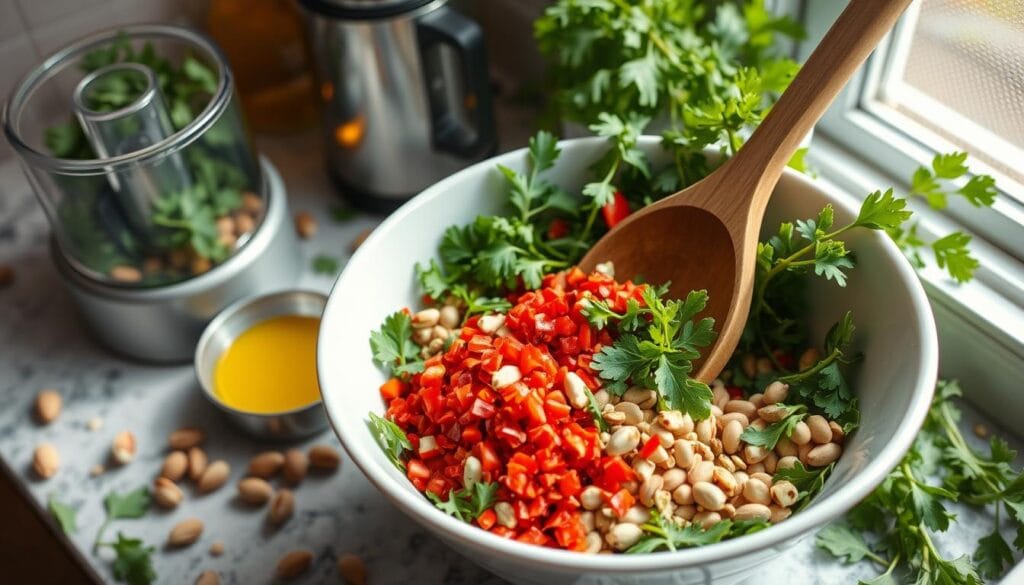
The secret to great pesto is balancing flavors and textures. With practice and creativity, you’ll make pesto like a pro.
Storage Solutions and Preservation Tips
Keeping your homemade pesto fresh is crucial. Whether it’s classic basil or a unique red pepper and arugula mix, the right storage keeps it tasting great. Proper methods can make your pesto last longer and stay flavorful.
Refrigeration Methods
For up to 3 days, store your pesto in the fridge. Use airtight glass or BPA-free plastic containers. Fill them fully to keep air out and prevent color changes. Adding a thin layer of olive oil on top seals it well.
Freezing Guidelines
Freezing is a great way to keep pesto longer. Put it in small, freezer-safe bags or containers. Flatten the portions to reduce air pockets. This keeps the flavor and texture good. Just thaw it in the fridge when you’re ready to use it.
Extended Shelf Life Techniques
- For refrigerated pesto, cover it with plastic wrap to stop oxidation and browning.
- Put a thin layer of olive oil on top to seal it and extend its life.
- Consider canning or jarring your pesto for even longer storage, using proper methods.
By using these tips, your homemade pesto will stay fresh and flavorful. Enjoy the taste of summer all year with these methods.
Creative Ways to Use Your Pesto
Discover the many uses of your homemade red pepper sauce arugula pistachio pesto. It can make a variety of dishes more exciting. Try new things and enjoy the taste of your homemade pesto.
- Toss the pesto with freshly cooked pasta for a quick and delicious meal.
- Spread the pesto on toasted baguette slices and top with creamy goat cheese for an appetizing bruschetta.
- Use the pesto as a sandwich spread to add a burst of flavor to your lunchtime favorites.
- Drizzle the pesto over roasted vegetables, such as zucchini, eggplant, or bell peppers, for a nutritious and vibrant side dish.
- Mix the pesto into soups, stews, or chili to enhance the overall flavor profile.
- Blend the pesto into salad dressings for a tangy and herbaceous touch.
- Spoon the pesto over grilled or baked fish, chicken, or tofu for a quick and flavorful protein-packed meal.
- Stir the pesto into rice, quinoa, or other whole grains for a nutrient-dense and satisfying dish.
- Use the pesto as a pizza topping to elevate your homemade or store-bought pies.
- Serve the pesto as a dip for fresh vegetables, such as carrots, celery, or bell pepper strips.
There are countless ways to use your homemade red pepper sauce arugula pistachio pesto. Try mixing it with different ingredients to find new favorites. It’s a great way to make your meals more exciting and impress your guests.

Being creative with your pesto is key. Let its unique taste guide you to new recipes. Enjoy finding new ways to use your pesto and make your meals even more delicious.
Troubleshooting Common Pesto Problems
Pesto is a tasty and versatile sauce, but it can face some issues. If you run into problems with your homemade pesto, don’t worry. We have the fixes to help you enjoy your pesto fully.
One common issue is pesto that’s too thick. To fix this, add more olive oil slowly until it’s creamy. If your pesto tastes too strong, a bit of honey or maple syrup can balance it. A squeeze of lemon or vinegar can also add a nice acidity.
Ever noticed your pesto getting darker in the fridge? It’s normal. To stop this, just put a thin layer of olive oil on top before sealing. For a spicier pesto, add red pepper flakes or a small jalapeño. These tips will help you solve common pesto problems and make it your own.
